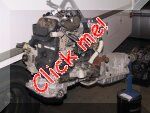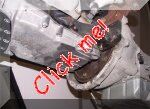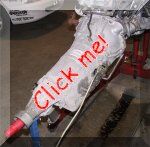
Welcome, from sunny Australia!
My AE-86 Corolla Page
The Altezza
3SGE conversion detailed

My AE-86 Corolla Page
The Altezza
3SGE conversion detailed
2-7-2003
The conversion has begun!
| Out came the low-kilometre 4AGE, and it's now waiting to go into the Starlet. Here you can see the NEVO under-drive pulleys quite clearly, and the 4AGZE crank angle sensor. | |
| Here is the 200hp Altezza 3SGE sitting it it's stand whilst being modified to go into the AE-86 engine bay. |  |
| To clear the AE-86 steering rack & mounts, the rear of the 3SGE sump had to be modified a fair bit, by removing a lot of webbing. This lets the engine sit down in the engine bay, with the bonus of being able to shut the bonnet. The downside is that so much alloy had to be removed that the flywheel is exposed and will have to be covered up with a small piece of fabricated sheet steel to stop rocks & debris getting in. |  |
| This is a better picture of the 5-speed 'tiptronic' type automatic gearbox. It's perhaps the easiest part of the conversion as it fits into the AE-86 gearbox tunnel without a lot of modification and the gear selector can be placed anywhere because it connects to the gearbox through that long rod hanging off the right hand side of the box. It's a bit hard to see in this picture, but the starter motor is very small for a two litre engine. |  |
| Due to the size of the 3SGE Altezza inlet manifold, there's not a lot of space around the brake vacuum booster. We're still not sure yet, but one probable solution is to fit the car with a twin master cylinder pedal box assembly. I bought one in the UK a couple of years ago on the chance that I might use it one day, and so that day may have come. It's also got an adjustable balance-bar, so I can alter the brake balance as I need to, to get the brakes just how I like them. We are also thinking about fitting the ABS anti-lock braking system from the Altezza into the Sprinter, but this may prove too difficult in the short term. |  |
10-7-2003
More progress, and more problems squeezing the big engine into the engine bay. More than what we thought anyway ...
Late November 2003
July 2004
November 2005
Ever since the 3SGE went in, it never ran properly. It's accelerate just fine, but cruising throttle would have the engine running roughly, as if the fuel mixture was very wrong. It'd also stall & die when slowing down so all in all not very pleasant to drive. I'd have to slow down by using the automatic gearbox in manual mode, going down through the gears to keep the revs up, and left-foot brake to keep the engine awake. So I really didn't do a lot with the car for many months ...
We narrowed down the problem to three possibilities - Fuel pressure, the two oxygen sensors in the wrong holes, and finally turbulent airflow over the hot-wire air flow meter in the inlet. After a lot of searching we finally found the right fuel pressure - 62psi - and we were very close to that anyway. I then went through the old build photos and found a couple that showed which oxygen sensor went in which hole - One sensor goes in the exhaust runners for cylinders #1 and #4, the other in the runners for #2 and #3. I thought that if we had those in the wrong way the computer would just keep trying to make the mixtures better, but in fact be making them worse. Initally I simply disconnected them to see if driving the car around made any difference, but it didn't so I had low hopes for this being the problem. The photos revealed that we did indeed have them the wrong way around, so after swapping them I hoped to see some sort of improvement. Well, unfortunately not!
That left just the inlet air flow ...
Things
to come:
-
Make the speedo work.
-
Fit the 4.1:1 diff ratio that the Altezza's have as standard so that
the speedo works accurately.
-
Fit the bigger brakes to the rear, to balance the large front brakes.
-
Finish off the interior panelling around the shifter.
To the mods done page
Back to the Index page
Page & contents where applicable © Bill Sherwood